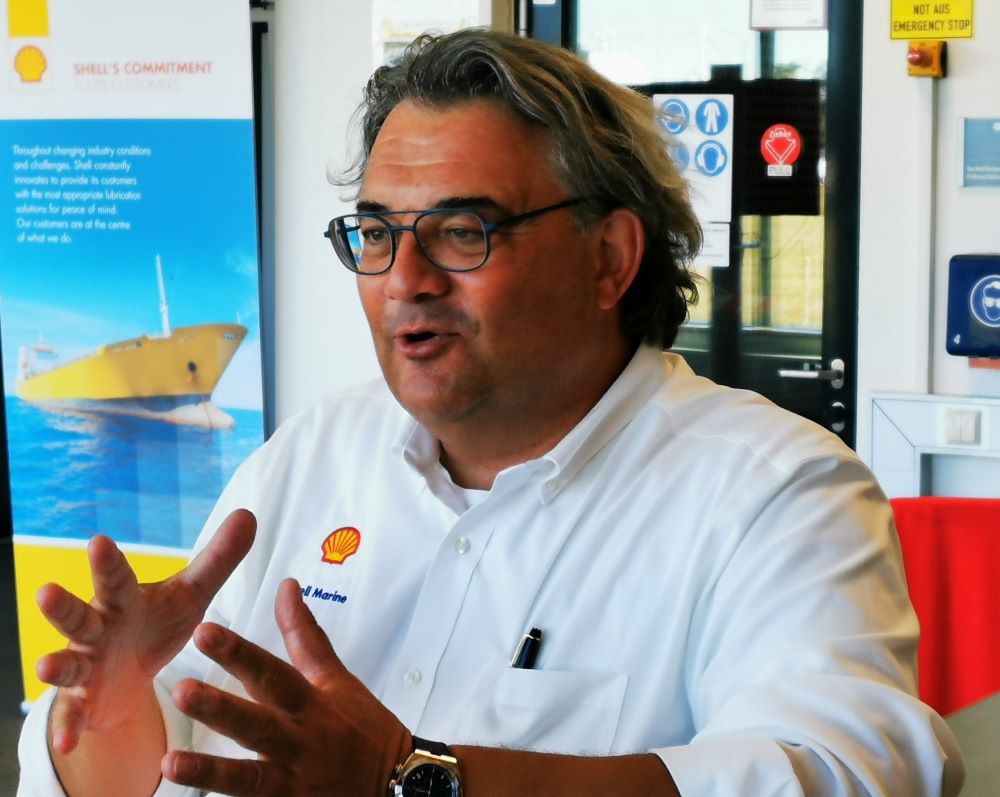In the maritime industry’s ever-changing landscape, new regulations, new fuels, new engine designs and constantly changing original equipment manufacturer (OEM) requirements are just some of the issues adding to the complexity shipping operators must navigate. At the same time, a crew’s understanding of their ship’s engine performance can often rely on data collected in a way that makes it challenging to spot underlying issues or long-term trends.
These factors combined mean that operators are increasingly seeking technical expertise that helps leverage data inputs to optimise operations, says Marcus Schaerer, general manager of Services & Technical at Shell Marine.
“At Shell, we have invested a lot of time talking to customers and understand their pain points. What we have learned is that the crew need help to maintain the reliability of their two-stroke engines, especially in a world with new fuels, new designs and new lubricants,” he tells The Naval Architect.
“For example, most crews still rely on traditional methods for cylinder monitoring, such as Excel. These methods haven’t changed for 25 years,” continues Schaerer. The implication of this, he explains, is that ships remain in a cycle of time-based maintenance rather than moving to a condition-based maintenance approach that could reduce instances of unplanned downtime and introduce significant efficiencies – when monitored properly.
“OEMs will give a lifetime for their cylinders of 16,000 to 20,000 hours. You can extend this up to 32,000 hours if you do condition-based monitoring,” Schaerer notes.
Consolidating the data
As a way forward, Schaerer points to Shell Marine’s digital platform Shell LubeMonitor, which he says surpasses traditional cylinder monitoring methods by combining data from onboard oil testing, engine operating conditions, Shell LubeAnalyst laboratory results, engine inspection photos and measurements to strike and maintain an acceptable balance between cylinder oil costs and wear-related cylinder maintenance expenses.
“Most operators already have all the data they need but it’s scattered, in different formats and locations… aboard and onshore. And the challenge with scattered data is that it doesn’t allow you to show trend lines and developments. You can’t view it in an organised way,” says Schaerer. Shell LubeMonitor automatically consolidates this data into a single platform, giving users a fuller picture of their ship’s engine performance. “It gives you clear advice based on OEM recommended guidance that allows you to take the appropriate actions at the right moment to reduce issues on board, adjust your feed rates, save cost and reduce maintenance,” Schaerer adds.
The platform offers several features that include enhanced vessel insights, from fleet level all the way down to individual cylinders, a step-by-step guide for onboard engineers to standardise the inspection process, and a comprehensive engine inspection feature that allows for the inclusion of recorded measurements such as piston ring clearance, piston ring coating and liner wear. It is available via the internet, iOS and Android operating systems, and has an offline logbook for easy submission of data, regardless of connectivity at sea.
Dedicated advisers
Additionally, the platform provides advice and recommendations from Shell Marine technical advisers. “Shell LubeMonitor is not just a software package,” stresses Schaerer, adding that whilst crews rely on their individual experiences, Shell Marine can draw on decades of experience, a whole team of experts, and learnings from across many customers.
“I like to compare it to going to the doctors’ or hospital if you a feeling unwell or need your regular checkup,” says Schaerer. “The doctors are our technical experts. Like lubricant analysis, the first thing they do is take a blood sample to see what that’s telling you. Then they run other tests and examinations and start combining the knowledge. If something is causing an irritation, then they say let’s talk, and three or four doctors will come together to form a diagnosis and find the right therapy. That’s very much what we are doing.”
Although not a new solution, Shell LubeMonitor – like fuels, engine designs and OEM requirements – keeps evolving, according to Schaerer. The original push for the platform, he says, came with two near-simultaneous events, the worldwide Covid-19 lockdown and the introduction of low-sulphur fuels in two-stroke engines following IMO’s 2020 0.5% sulphur cap.
“Operators discovered that the heat and pressure low-sulphur fuels generate was creating deposits on the engine’s power unit which can make the engine breakdown or run less efficiently. Deposits cannot be seen through [lubricant analysis] samples or onboard tests, only by visual inspection. So in just four months, which is lightspeed for a company like Shell, we developed an app to remotely assist crews with their inspections,” he explains.
From there, other parameters were added to give operators and crew a more holistic view of operational conditions in the cylinders and combustion chamber, providing a “go-to place for all engine monitoring needs”. Today, the platform can harness nearly 30 years of data, including a library of over 8,000 images and around 300,000 test samples, and uses artificial intelligence to filter information and help deliver meaningful advice.
A collaborative approach
Initially developed solely for Shell Marine lubricant customers, the next step for Shell LubeMonitor is to make it available to all shipowners and operators, no matter which brand of lubrication they use, and to integrate it with other systems. “We have some customers who, for commercial reasons, have decided to go for another brand of lubricant but still stay on the LubeMonitor, which demonstrates the value of the platform,” says Schaerer.
“We also don’t want to work alone, but instead connect it with other platforms, making sure that whatever knowledge we have is openly shared with whatever data model the customer is using,” he adds. Schaerer concludes that he believes this collaborative approach is essential to tackling the complex challenges facing the maritime industry.




